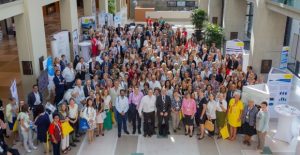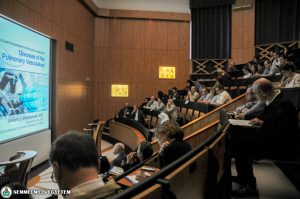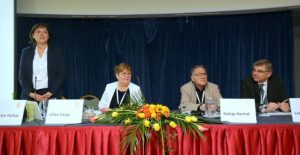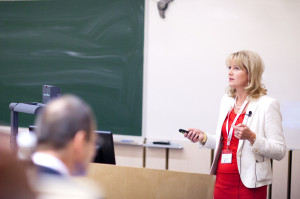 Innovation in Medicine, the three-day conference held by Semmelweis University is to be the cornerstone of a new tradition. Dr. Mária Judit Molnár, Vice-Rector for Scientific Affairs pointed out that the conference aims to develop into a series of events focusing on the most up-to-date and dynamic areas of modern medicine. “The rapid pace of the developments in the field of diagnostics, therapy, information technology and bionics gives ample opportunity for discussion every year”, she said.
Innovation in Medicine, the three-day conference held by Semmelweis University is to be the cornerstone of a new tradition. Dr. Mária Judit Molnár, Vice-Rector for Scientific Affairs pointed out that the conference aims to develop into a series of events focusing on the most up-to-date and dynamic areas of modern medicine. “The rapid pace of the developments in the field of diagnostics, therapy, information technology and bionics gives ample opportunity for discussion every year”, she said.
A symposium accounting for the latest results of the National Program in Brain Research opened the conference. The second day focused on specialised medical programmes, whereas on the third day the general public could get an insight into the latest inventions of medicine, and the future of healthcare.
At the opening of the second day Dr. Mária Judit Molnár said that the event is outstanding in its relevance to modern day medicine and its international nature. The development of scientific and technological achievements has speeded up and made a deep impact on medical education, research and practice. “Today’s fiction is tomorrow’s reality”, emphasized Dr. Mária Judit Molnár referring to human genetic engineering and 3D printing of human organs.
S he also mentioned that the development of biomedical science and healthcare requires the cooperation between educational and research institutions and their industrial partners. Together they could seek ways to enhance developments and support the adoption of the results and innovative ideas of university researchers. She expressed her views on how important such events are in the formation of such partnerships.
he also mentioned that the development of biomedical science and healthcare requires the cooperation between educational and research institutions and their industrial partners. Together they could seek ways to enhance developments and support the adoption of the results and innovative ideas of university researchers. She expressed her views on how important such events are in the formation of such partnerships.
Dr. Szabolcs Szuromi, Rector of Pázmány Péter Catholic University highlighted the importance of the Bionic Innovation Centre being built as a joint project of Semmelweis University and Pázmány Péter Catholic University, which will give ground to interdisciplinary research.
The main focus of the first section on the second day was personalised medicine and the treatment of patient groups. This means that sub-groups are created from bigger diagnostic groups with the help of genetic features, then medication is optimised based on the specifications of the sub-groups. There were two presentations in the field of oncology where this approach is widely used.
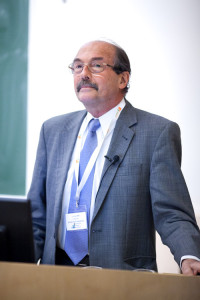 Dr. György Kéri, research professor of the Department of Medical Chemistry, Molecular Biology and Pathobiochemistry spoke about cutting edge discoveries in the research of cancer and chronic inflammatory diseases. He explained that the formation of tumours is influenced by several genes; however the mutation of the so called driver genes can be accounted for the occurrence of neoplastic diseases.
Dr. György Kéri, research professor of the Department of Medical Chemistry, Molecular Biology and Pathobiochemistry spoke about cutting edge discoveries in the research of cancer and chronic inflammatory diseases. He explained that the formation of tumours is influenced by several genes; however the mutation of the so called driver genes can be accounted for the occurrence of neoplastic diseases.
Dr. András Kiss, associate professor of the II. Department of Pathology spoke about the possibilities of personalised treatment of various tumours. Dr. György Németh, the President of the Hungarian Society of Personalised Medicine revealed the challenges of personalised medicine, ranging from basic research through clinical application to its importance in public healthcare. Dr. Dhavendra Kumar, professor of clinical genetics at Cardiff University gave a comprehensive presentation on molecular targeted therapy, and also pinpointed the role played by genetics and lifestyles in the evolvement of cardiovascular, cardiologic diseases and cardiac arrest.
Two young and outstanding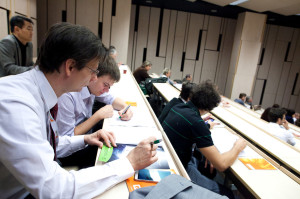 researchers were introduced by Semmelweis University’s Innovation Centre – Technology Transfer Office, who have succeeded in turning their ideas into reality. One of them managed to start a spin-off company while the other one started a lucrative SME dealing with stem cell research. Both companies have also been very successful in international tenders.
researchers were introduced by Semmelweis University’s Innovation Centre – Technology Transfer Office, who have succeeded in turning their ideas into reality. One of them managed to start a spin-off company while the other one started a lucrative SME dealing with stem cell research. Both companies have also been very successful in international tenders.
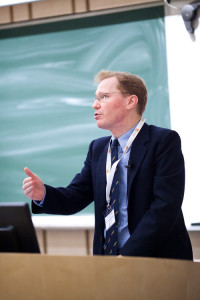 Five presentations in the afternoon sessions focused on interventional neurology. Peter Sandercock from Edinburgh gave an account of the treatment of acute stroke with anticoagulants. Other presenters addressed topics such as contemporary neurosurgical treatment of stroke and the innovative remedies in handling ataxia and chronic pain. The last presentation of the session gave an informative view on methods developed by doctors and engineers monitoring cerebral blood flow.
Five presentations in the afternoon sessions focused on interventional neurology. Peter Sandercock from Edinburgh gave an account of the treatment of acute stroke with anticoagulants. Other presenters addressed topics such as contemporary neurosurgical treatment of stroke and the innovative remedies in handling ataxia and chronic pain. The last presentation of the session gave an informative view on methods developed by doctors and engineers monitoring cerebral blood flow.
According to Dr. Mária Judit Molnár the objective of the three-day-long conference was to highlight the latest researches, technologies, developments and the results achieved, as well as to set an example for young, and talented. “It is important for young researchers to think outside laboratories, to see how their ideas can be realised and not to be afraid to initiate changes.”, she said.
In the Vice-Rector’s opinion the presentations proved that there are boundless opportunities for young researchers and the university’s role is to support creative ideas and talented individuals, to set them on the right path and to provide them with professional and helpful technology transfer managers.
Pálma Dobozi
Szilvia Tóth-Szabó
Translated by: Agnes Raubinek
Photo: Attila Kovács – Semmelweis University, Akadémiai Kiadó
